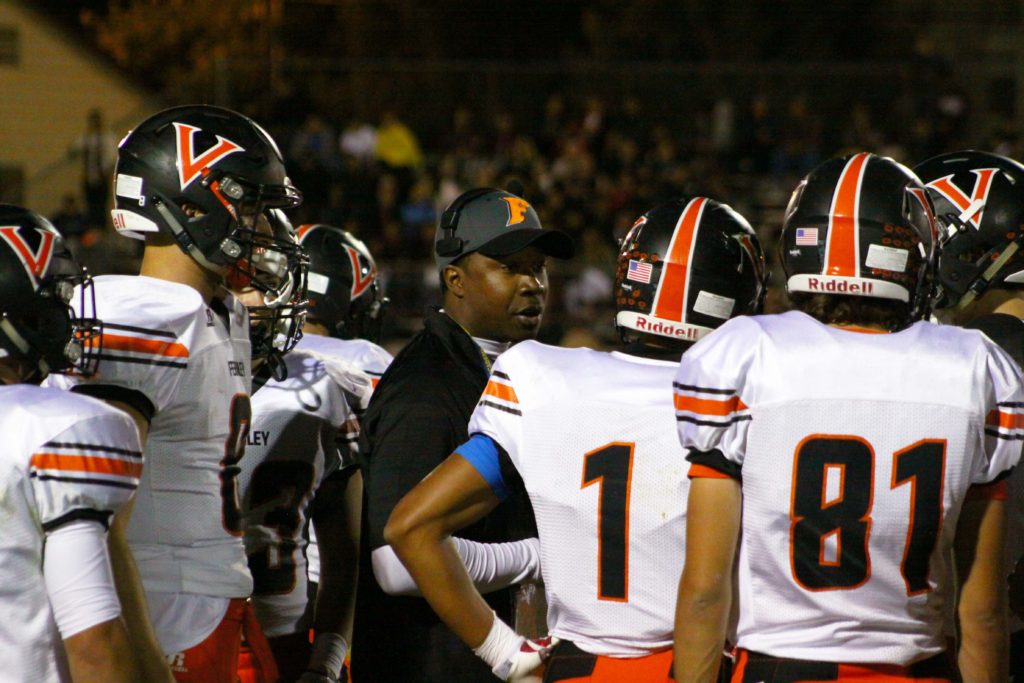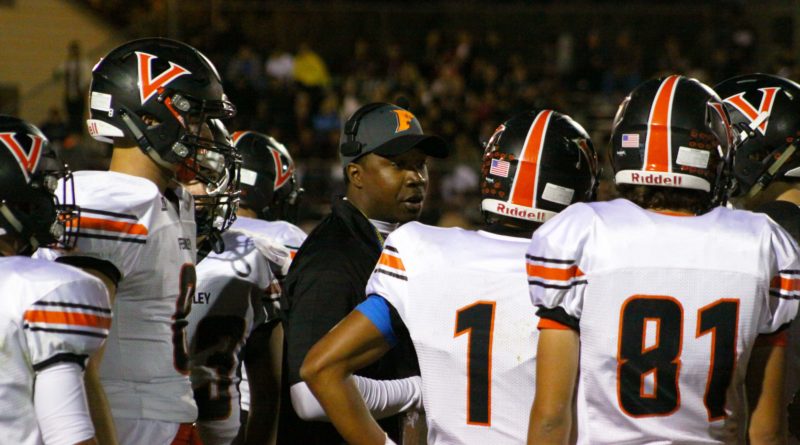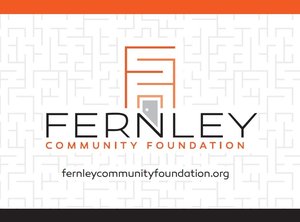Martin helps Fernley flexbone take flight

Eddie Martin talks with players during a timeout in a game earlier this season at Sparks.
Robert Perea, The Fernley Reporter
On a shelf at home, Fernley football coach Chris Ward has a book called “The Explosive Double Slot Offense”, and over the years he spent time watching Army, Navy and Air Force consistently be among the best offenses in college football despite never having the type of talent found at Alabama, Florida State, or more recently, Oregon or Clemson.
One particular play in that book, a triple option, piqued Ward’s interest, and became the foundation for the flexbone offense Ward brought with him when he became head coach at Fernley in 2008.
But a chance meeting at a Fernley gym between one of Ward’s assistant coaches and a player who ran the flexbone as a quarterback at Navy has turned Fernley’s flexbone from just another difficult offense for defenses to prepare for, to the biggest reason the Vaqueros enter the playoffs this week as the regular season champions of the Northern 3A.
Ward was in his office one day before last season when assistant coach Tony Wilson came in and told him about a guy he’d met at the gym.
“Coach Wilson came in and he said, hey, I met this guy down at the gym, and he goes, he knows football, in fact he played at Navy,” Ward said.
That guy was Eddie Martin, who played at Navy from 2003-05, as a backup quarterback his first two seasons, before switching to slotback, and who brought to Fernley his firsthand knowledge in running the flexbone offense, learned directly from the man who invented it.
Martin had moved to Fernley the summer before, after being transferred to NAS Fallon, where he serves as an intelligence officer.
Ward was interested enough to ask Wilson to get Martin’s phone number, and the result has been a transformation of the culture of the Fernley football program.
“I didn’t know what capacity we could get him or anything like that, how tied up he was going to be with his commitment at Navy,” Ward said. “But he started coming to practice all the time and the fact that we were trying to run flexbone stuff without no one really having played in it.”
Before Martin’s arrival, none of the Vaqueros’ coaches had any first hand experience playing in the offense they were trying to teach.
“I think I came the closest by running split back veer when I was in college, trying to take lot of those principles and turning it into flexbone,” Ward said.
Ward had started getting into the flexbone when he was coaching at Conrad, Montana,
“We had to offset our back to one side and we ran outside veer and tackle trap, were our two plays, and it took us all the way to the state championship game,” Ward said. “I was kind of a believer in it and you try to learn it on your own, but then I stumbled into Eddie about 20 years too late.”
Martin played football, basketball and baseball at J.M. Tate High School in Cantomment, Fla., 20 miles north of Pensacola. He graduated in 2003 and although baseball was his main sport in high school, was recruited to play football by all three of the U.S. military academies.
“It’s just something about this game, it teaches so much,” Martin said. “I’m not saying baseball doesn’t, but football just teaches so many life lessons that really can’t be taught or duplicated doing anything else.”
Martin initially chose the Air Force but he felt drawn to the culture at Navy, even though the football team wasn’t as good at the time
“My class of 2007, we came in 2003, started the wave of the success that Navy’s had now,” Martin said. “I just felt like I belonged there. It was just something about the place, hearing the seniors talk about coming there and being a part of turning around the program.”
Martin went to Navy as a quarterback, but the team had two quarterbacks entrenched ahead of him, Craig Candeto, who is now the quarterbacks coach at Georgia Tech, and Aaron Polanco.
In his junior year in 2005, Martin switched to slotback, where he played in every game that season.
But before his senior season, Martin was diagnosed with Hodgkin’s Lymphoma, and although that ended his football career, he honored his commitment to the Navy.
During his time at Navy, Martin said he became close with his position coaches, quarterbacks coach Ivin Jasper, who is now Navy’s offensive coordinator, and running backs coach Jeff Monken, who is now head coach at Army, and he said he still speaks with them regularly
The head coach during Martin’s years at Navy was Paul Johnson, who essentially invented the flexbone.
The offense
Johnson started experimenting with the flexbone offense at Georgia Southern in the mid 1980s, and was offensive coordinator when the team won consecutive Division I-AA national championships in 1985 and 1986. Johnson took the flexbone with him when he went to Hawaii as offensive coordinator in 1987. Hawaii had been running the run-and-shoot offense, a passing offense that was all the rage in college football in the 1980’s, which had two receivers split wide and two receivers in the slot, with a single running back. Johnson’s offense essentially combined the run-and-shoot formation with the wishbone, using his slotbacks as dual running back and wide receiver threats rather than as two halfbacks behind the fullback.
Johnson later became head coach at Georgia Southern in 1997, was head coach at Navy from 2002-2007 and has been head coach at Georgia Tech since 2008.
The offense allows for multiple variations, and in the past several seasons, the Vaqueros have run it with the quarterback under center with the fullback behind him, out of the shotgun with the fullback offset, or out of the pistol formation, also with the fullback behind the quarterback.
Ward likes the flexbone because, with two receivers split out wide, and two slotbacks lined up on each side of the line, outside of the tackles, the formation works simultaneously as a three running back set, and a four receiver set, giving the offense the ability to run its entire package of plays without tipping its hand to the defense by changing formations.
Because so few teams run the offense, Ward said it has the added benefit of making Fernley’s opponents spend valuable practice time preparing specifically for them.
“I don’t know if there’s another flexbone team in the state,” Ward said. “We’re unique, and I know teams gotta do things to prepare for us.”
Because it’s used primarily as a running offense by most of the teams that run it, and defenses have to expect the run on almost every down, the flexbone gives the offense the ability to be an explosive passing team. Johnson’s teams are annually among college football’s best rushing teams, but at Georgia Tech, his offense has produced two wide receivers who went on to become among the best in the NFL, Calvin Johnson and Demaryius Thomas.
The flexbone is based on numbers and angles, and because almost every action is predicated on a read by the quarterback during the play, the offense can attack a defense’s vulnerabilities or overplays in mid play, instead of relying on a play call to attack a particular area of the defense. The offense comes to the line of scrimmage knowing that two specific defenders will not be blocked, and on running plays, it’s the quarterback’s job to read those two defenders and decide whether to hand the ball to the fullback, keep it himself or pitch to one of the slotbacks running outside.
“I call it the great equalizer,” Martin said. “That’s exactly what it is, it evens the playing field. You look at the time that you actually have to practice at the high school level, it works well for what we do.”
Firsthand expertise
Although his snaps during his two years as a backup quarterback were limited to practice, Martin became intricately familiar with not just how to run the flexbone, but the concepts within it and the reasons behind them. It’s that firsthand experience with the offense, and the ability to teach those concepts, that Ward and his staff lacked before Martin arrived.
“I learn stuff every day going out to practice with him, and then when we meet up on Sundays and go over stuff, and it’s the stuff you can do out of it that I never really thought about, that he knows,” Ward said. “And I’m sure we’re not even scratching the surface, really, of what we could do. “
After graduating from the Naval Academy, Martin was stationed in several places around the Washington D.C. area, including an assignment at the Pentagon. While there, he got into coaching, both in high school and in youth leagues. Even at that level, coaching kids as young as 11 years old, Martin taught the flexbone.
“Having learned it from I guess the guru who created this stuff, one thing I feel like I’ve always been pretty good at is communicating and relating to kids,” Martin said. “So I’d always get calls around the area where people are like, you run this offense, but how do you teach that to 11 and 12 and 13 year olds? I’m like, it’s pretty simple, just break it down, and then you allow them to see exactly what you’re trying to envision for the guys that do it.”
Martin said flexbone is all about attention to detail.
“It’s as complicated as you want to make it, but the big thing comes down to small things, and they build on each other,” he said. “So when you can do the repetitions over and over again, that’s when you get success out of it.”
But as much impact as Martin’s expertise with the scheme, and ability to teach how to run the plays, has made on the Fernley football program, his impact spiritually might be even bigger.
In the aftermath of their 21-20 win over Truckee on Oct. 20 that clinched the regular season league title, several different players spoke about the “brotherhood” of playing for each other.
“What I’ve carried on to try to bring here, bring that type of culture here about the brotherhood that’s big with us, the Navy brotherhood, is trying to instill that culture here and get these guys to play for each other,” Martin said. “That’s the good thing about being in the Navy, you move to different places, but one thing I always had the motto where I went, I tried to make sure I made an impact on the community before I left.”
Martin still keeps in touch with his coaches at Navy, particularly Ivin and Monken, and with kids he coached. Before coming to help Fernley last season, his last year coaching was 2011.
“I was working at the Pentagon and I ended up taking a job that basically had crazy hours, so I had to give up coaching,” he said. “I kind of let it go and just kept in contact with the guys I had coached.”
After his assignment at the Pentagon, Martin was deployed for a 10-month tour on the USS Carl Vinson with Carrier Wing 17 as a targeteer. He was then transferred to NAS Fallon, but he moved to Fernley just before the 2015 season.
But last summer, he was working out at Anytime Fitness when he ran into Tony Wilson.
“So once I came out here and came in contact with coach Wilson, I just gave the thought and see if I can go help out,” Martin said.
Martin initially planned to teach some quarterback fundamentals, but then wound up working with the offense for several weeks.
“It kinda turned into kind of give them an option camp, kind of a camp for free, and then it motivated me to kind of want to get back into it, and I had to take advantage of the opportunity,” Martin said.
Martin worked closely with the offense last season, teaching the players and coaches some of the intricacies of the flexbone offense.
When last year’s offensive coordinator, Sean Cecconi, had to leave the program for family reasons, Martin assumed the role of offensive coordinator this season.
Martin’s impact on the offense was obvious immediately. After struggling to get a rhythm in the first game of the season against Sacred Heart Cathedral in San Francisco, the Vaqueros rallied from a 12-point deficit to beat Fallon for the first time in nine years in the second week of the season, and from there rolled to an unbeaten league season.
But while he calls each offensive play during the game, most of Martin’s influence on the offense happens on the practice field, not during the game.
“I just tell the quarterback to stick to his gut and read everything that we need to read and it’ll play out exactly how we need to,” Martin said. “That’s the beauty of the option, the quarterback has three reads, because the defense can decide to take away the dive on one play, and then decide they want the quarterback, so you don’t need to guess. Whatever you see, trust your eyes and trust your reads and go with it.”
Martin said he learned from Johnson and Jasper about preparing for each week, and having an answer for whatever new or unexpected wrinkle a defense might show.
“Me calling plays, what I’ve seen is more of a flow or more of a feeling of what I see,” Martin said. “My big thing is I try to look at what they give me and then make adjustments off of it and just try to be ahead of the next couple calls that the defensive coordinator may bring up. If teams say they’re going to commit to take away the dive, then you need to be able to get to the other phases of the game, which could be you may have the quarterback running twice as much as he has in the past, or have the ball pitched out on the perimeter.”
Next steps
Martin’s orders assigning him to NAS Fallon were originally supposed to be for two years, and he expected to be transferred in November or December last year.
“Part of our talk (last season) was hopefully I didn’t leave before the season ended, and I was like no, I would work it so that I make sure that I get past the playoffs,” Martin said.
Martin’s stay in Fallon ended up being extended, and after believing they would lose Martin after last season, Ward was thrilled to find out that he would return this season. Martin joked that Ward made several phone calls to Navy brass to keep him stationed in Fallon, but he said it now seems like divine intervention.
“I was like, well, maybe it was meant for me to stay and get another year with the guys, because what happens is when I get involved in stuff, man, I get very attached to it, so I felt like once I became a part of the kids’ lives, it’s like, hey, finish what we started,” Martin said. “Beyond the kids, I love the coaching staff, coach Ward, coach Ward’s family, everyone. It’s just an awesome community.”
When he arrived at NAS Fallon, Martin decided to live in Fernley because of its location closer to Reno.
“If I wanted to be able to get to Reno, where more of the eateries are, it’s the halfway point, and so that made it easier, and the drive‘s not that bad,” Martin said. “I came from D.C., where you sit in two hours of traffic just to get 15 miles.”
And just as coming to Fernley turned out to be a stroke of luck that connected him to the Vaqueros, so has it turned out to be a professional boon to Martin, who received a promotion to Lieutenant Commander.
Although he has relished working with the football program and being a part of the lives of the players, Martin is anxious to move on to his next assignment, hopefully back in the Washington D.C. area.
That’s where his wife, Keri, and son Easton, who is now about five months old, still live, and where Keri works for the U.S. government.
“I appreciate everything she does, allow me to be able to have my sanity while I’m waiting to get sent back there,” Martin said. “It’s very tough because my kid’s growing so fast, I have to look at him via Facetime. I won’t forget when I flew in the last time, I get in the car and he’s just boo hoo crying, and I was like man, he didn’t even recognize me because I was gone for a few weeks.”
In the meanwhile, Martin and the Vaqueros embark in pursuit of a state championship Thursday night, when they host Truckee in a Northern 3A playoff game.
That means Martin has at most three games left with the Vaqueros, even if his impact will be felt long after he’s gone, both on the field and in the lives of the players.
And it’s been football, and more specifically the flexbone offense, and a chance meeting in a Fernley gym, that made it all possible.





Great, in-depth article!
Pingback: Snippets from Fernley’s State championship win over Fallon